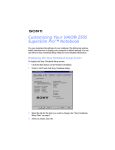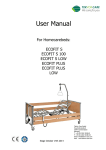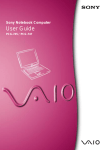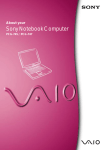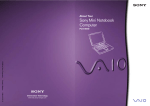Download PCG-F150 - Sony Europe
Transcript
About the Software on your Sony Notebook Computer PCG-F150 NOTICE This product contains software owned by Sony and licensed by third parties. Use of such software is subject to the terms and conditions of license agreements enclosed with this product. Software specifications are subject to change without notice and may not necessarily be identical to current retail versions. Updates and additions to software may require an additional charge. Subscriptions to online service providers may require a fee and credit card information. Financial services may require prior arrangements with participating financial institutions. Sony, VAIO and i.LINK are trademarks of Sony Corporation. The Intel Inside logo, MMX, and Pentium® II are registered trademarks of Intel Corporation. Microsoft, Windows, and the Windows® 98 logo are trademarks of Microsoft Corporation. All other trademarks are trademarks or registered trademarks of their respective owners. As an ENERGY STAR Partner, Sony has determined that this product meets the ENERGY STAR guidelines for energy efficiency. The International ENERGY STAR Office Equipment Program is an international program that promotes energy saving through the use of computers and their office equipment. The program backs the development and dissemination of products with functions that effectively reduce energy consumption. It is an open system in which business proprietors can participate voluntarily. The targeted products are office equipment such as computers, displays, printers, facsimiles and copiers. Their standards and logos are uniform among participating nations. ENERGY STAR is an U.S. registered mark. © 1999 Sony Corporation All rights reserved. Reproduction in whole or in part without permission is prohibited. 3 Contents About the Software on Your Notebook Computer Sony software....................................................................................5 Operating System and other pre-installed software ...................8 Communication software..............................................................10 Customizing Your Notebook Computer Sony Notebook Setup ....................................................................13 PowerPanel......................................................................................15 Displaying Battery Information ...................................................20 Starting Your Favorite Software With Programmable Power Key (PPK) Setup .............................................................................23 Changing the Pointing device settings........................................25 Selecting the Display Mode ..........................................................27 Using the Dual Display Function.................................................31 Using the Media Bar .......................................................... 33 Media Bar Functions ......................................................................34 4 About the Software on Your Notebook Computer Your Sony notebook computer is ready to help you work, play, learn, and communicate as soon as you turn it on. This section gives you an overview of the activities you can perform with your software titles. For general information, please refer to your Customer Service Guide. Sony software MD Editor Sony Electronics When you connect a Sony MD deck that includes a CONTROL A1 jack to your computer, you can use this software to operate the MD deck from the computer. In addition to the normal MD playback operations, you can edit MiniDisks while viewing the computer's display and input disc names and track names using the computer's keyboard. In addition, if you connect a Sony CD Player that includes a CONTROL A1 jack to the MD deck, you can also operate the CD player (playback) from the computer and carry out drag-and-drop recording from a CD to an MD. For questions, compatibility and technical assistance, please read the MD Editor Help file or your Customer Service Guide. PictureGear Sony Electronics Create your own environment with the Digital Image Library (photos, backgrounds, wallpapers, slide shows, etc). PictureGear is your assistant for creating and implementing personal screen savers... You can even animate your preferred gifs with Gif Animation Tools. For questions and technical assistance, please read your Customer Service Guide. DVgate Still Sony Electronics Attaching a DV device to the i.LINK connector enables you to transfer the images you have captured to your hard drive. DVgate Still displays digital video images sent from a digital video cassette recorder or a digital video camera recorder, and 5 About the Software on Your Notebook Computer captures them as still pictures on your notebook computer. For more details please refer to the on-line help files. For questions and technical assistance, please read your Customer Service Guide. Media Bar Sony Electronics The Media Bar allows you to play audio and video CDs in the CD-ROM drive or play audio or video files in various formats on your hard drive.Video images are displayed in a separate Movie window, which you can move and resize (to full screen). See a summary of the features in “Using the Media Bar” on page 33. For questions and technical assistance, please read your Customer Service Guide. PPK Setup Sony Electronics PPK Setup sets the three programmable Power Keys (on the top of the keyboard). The 12 settings enable you to start any application you want, to establish a dialup connection or read an e-mail by simply pressing the programmable Power Keys in combination with other control keys. See the chapter “To use the PPK Setup screen:” on page 23 for details. VoiceMemo Sony Electronics VoiceMemo enables you to record the voice and play back reminders when needed; for example, recording phone numbers or appointment times. It can also be used as a normal memo with text. For questions and technical assistance, please read your Customer Service Guide. BatteryScope Sony Electronics BatteryScope is a flexible battery management system that gathers critical information from the battery in your notebook computer, processes it, and displays the information on the screen in a way that is easy to understand. For questions and technical assistance, please read your Customer Service Guide. PowerPanel Sony Electronics As a major component of PowerSuite, the PowerPanel utility controls the power management of your notebook computer and provides key information about system activity and battery life. Automatic power management selects the most appropriate profile, depending on the application you’re working with and the conditions of use. See the chapter “Controlling Power Management” on page 15 for more information. PowerPanel Help also provides futher details. 6 Sony software Sony Notebook Setup Sony Electronics Use the Sony Notebook Setup to confirm system information, specify preferences for system behavior, and change hardware settings for your Sony Notebook computer. For more information, refer to the chapter “Sony Notebook Setup” on page 13 or click Help on the Notebook Setup screen to display the help file. For questions and technical assistance, please read your Customer Service Guide. Product Recovery CD-ROM Sony ITE The Product Recovery CD-ROM allows you to reinstall individual applications and device drivers if they are corrupted or accidentally erased. It also allows you to restore the software titles that were shipped with your computer if they become corrupted or are erased accidentally. Reinstalling an individual device driver or software title may correct a problem you are experiencing with your computer, and you may not need to recover the entire contents of your hard drive. ! You can only use this Recovery CD-ROM on the Sony notebook you purchased and not on any other Sony PC or other manufacturer's PC. 7 About the Software on Your Notebook Computer Operating System and other pre-installed software Windows® 98 Microsoft Corporation Microsoft® Windows® 98 makes your computer work better by integrating tightly with the Internet and providing better system performance and easier system diagnostics and maintenance. With Windows 98, your system plays better as well with support for the latest graphics, sound, and multimedia technologies, easy addition and removal of peripheral devices, and the convergence of the TV and PC in your home. This exciting new operating system builds on the groundbreaking features introduced with Windows 95. At the same time, Windows 98 maintains the best support for older Windows-based applications and technologies. For questions and technical assistance, go online to http://www.microsoft.com/support/ Internet Explorer 4.01 Microsoft Corporation Internet Explorer is the Internet browser of Microsoft.The Setup Wizard configures your computer to connect automatically to the service provider of your choice. A full e-mail package enables you to send and receive mail—including attached files—across the Internet. NetMeeting, Outlook Express and Microsoft Chat are just some of the components bundled with Internet Explorer 4.01. A complete online tutorial helps new users become comfortable using the Internet. For questions and technical assistance, go online to http://www.microsoft.com/support/ Adobe® Acrobat® Reader 3.01 Adobe Systems Incorporated Acrobat Reader software allows you to view, navigate, and print electronic documents in Adobe Portable Document Format (PDF), an open file format that is intended to preserve the fidelity of documents created on all major computer platforms. Once Acrobat Reader is installed, you can open and view PDF files from within your Web browser by clicking on a PDF file embedded in a HTML file. You quickly see the first page while the rest of the document is being downloaded. Use the Acrobat Reader to read the Sony Notebook Computer User Guide online. For questions and technical assistance, go online at http://www.adobe.com QuickTime 3.0 Apple QuickTime is the Apple technology that makes video, sound, music, 3D and virtual reality come alive for Windows. Now QuickTime takes your multimedia capabilities to the next level - and the one beyond. QuickTime 3.0: offering the best in video, sound, music, and voice compression 8 Operating System and other pre-installed software technologies, QuickTime 3.0 also lets you experience video and audio as soon as they arrive. QuickTime VR transports you to virtual reality. Rotate objects, zoom in or out, look in any direction and navigate from one scene to another. For further information, see the web site at http://www.apple.com/quicktime/ VirusScan McAfee VirusScan is McAfee's powerful and advanced anti-virus solution. If a virus is detected, VirusScan can attempt to remove it from the infected file, move the file to a quarantine location, or delete the infected file. VirusScan is an important element of a comprehensive security program that includes a variety of safety measures such as regular backups, meaningful password protection, training, and awareness. For details, please refer to the online help files or for technical support, go to http://www.mcafee.com 9 About the Software on Your Notebook Computer Communication software Phone Tools BVRP Software PhoneTools is a powerful communication tool which provides a full range of features: fax, dialer, telephone directory through an user-friendly interface. In addition, PhoneTools allows complete management of GSM cellular phone: phone directories and short messages. Online manual and contextual help are provided with PhoneTools. COM One Platinium Card Loader COM One Company The Platinium Card loader allows users to upgrade or change the functionnalities of the PC card modem (firmware of the card is changed). The Platinium Card is delivered with PSTN V.90, ISDN* and GSM Sony CMD-Z1* functionnalities. The upgrade or change can be made by selecting a new firmware (card programming) in the list provided with the Loader software or by accessing COM-ONE Web site (http://www.com1.fr). See the online Platinum Card Manual. ✍ *See your retailer for GSM and ISDN kits. 10 Communication software Features offered by PhoneTools with your Platinium PC card: Fax transmission: Via PSTN: Your notebook is delivered with PhoneTools and the PC card configured for fax transmission. Via GSM: If you own a Sony GSM CMD-Z1 or CMD-Z1 Plus, you can purchase a cable to connect your phone to the PC card: without modifying the settings, PhoneTools will allow you to send and receive faxes through your mobile phone. Connection cables for Sony GSM CM-DX1000 and CMD-X2000 are also available. In order to use this GSM, you must update: - the PC card settings ,by using the COM1 Platinium Loader program (select the settings matching your mobile phone) - the PhoneTools driver (see Configuration/Hardware Configuration/Select modem): select the MC220 + ISDN + the mobile phone you are using. With other GSM phones, the set of functions offered by Phonetools may be limited. Via ISDN: You can purchase an ISDN kit from COM1 company or VAIO Direct. It will allow you to send and receive faxes via ISDN. GSM Special Features: If you own a Sony GSM CMD-Z1 or CMD-Z1 Plus or CMD-X2000, PhoneTools allows you to: - send and receive SMS (this depends on your GSM subscription) - manage your GSM Phone Book for an easy update of your GSM telephone directories. Dialer function: When a telephone is connected to the same line as your notebook modem (PSTN), the dialer function allows you to dial from the Phonetools telephone directory. However, the actual telephone conversation will be conducted via your regular telephone. Data transmission: Microsoft HyperTerminal provided with Windows 98 allows you to transmit data via PSTN, ISDN and GSM networks. 11 12 Customizing Your Notebook Computer You can customize the settings of your notebook computer. The following sections briefly describe how to change your computer’s settings. You can also refer to the Help files of the software for more detailed information. In addition, you can select the display modes via NeoMagic and enjoy the benefits of displaying your desktop on two screens. ❑ Sony Notebook Setup, page 13 ❑ PowerPanel, page 15 ❑ BatteryScope, page 20 ❑ PPK Setup, page 23 ❑ NeoMagic tab, page 27 ❑ Dual Display function, page 31 Sony Notebook Setup To display the Sony Notebook Setup screen: 1 2 Click the Start button on the Windows 98 taskbar. 3 4 Select the tab for the item you want to change. In Programs, select Sony Notebook Setup. The “Basic” window will appear; you can then enhance the features by clicking the “Advanced” tab. After you finish, click OK. 13 Customizing Your Notebook Computer Notebook Setup Tabs Tab Descriptions About This Computer Display system information, including memory capacity, serial number, and BIOS version. Printer Select printer port mode settings. Power On Device Sequence Select the drive and device order you wish to use for loading the operating system. You can specify the hard drive as well as other drives inserted into your computer. Touchpad You can disable your touchpad by connecting an optional mouse to your computer’s mouse port (PS/2 or USB). You can also customize the settings of your mouse using the mouse utility. Power On Password Set the password to secure your computer. Audio Change the volume when loading the operating system. Enable Ports Disabling ports releases resources to the system. To change the serial, infrared settings, click Advanced on the Basic/Advanced tab. Basic/Advanced Toggle between Advanced mode (additional screens with advanced settings) and Basic mode of display. Advanced mode includes Serial, Infrared and View Resources tabs. ✍ For more information about each option, click Help on the Notebook Setup screen to display the help file. 14 PowerPanel PowerPanel Controlling Power Management The PowerPanel utility controls the power management of your notebook computer and provides key information about system activity and battery life. In combination with BatteryScope, the automatic power management selects the most advantageous profiles, or lets you customize the profiles you choose, according to your own needs, with the goal of extended battery life. ✍ When you use the battery pack as power source, your system selects the Maximum Battery Life power management profile by default. If you select a different power management profile while using battery power, the same profile will be automatically selected the next time you use the battery pack to power your computer. PowerPanel main features ❑ Automatic Profile Selection (APS) based on the currently active application ❑ Ability to select special Power Profiles manually from the menu ❑ Ability to edit and create new profiles ❑ A toolbar shared with BatteryScope ❑ Works in harmony with Windows settings. To activate PowerPanel When you start your computer, the PowerPanel tasktray appears on the taskbar by default. If the tasktray does not appear, right click the taskbar at the bottom of the screen. Select Toolbars from the pop-up menu, then click PowerPanel. The PowerPanel will appear on the task bar, or: 1 2 Click the Start button on the Windows 98 taskbar. In Programs, select (PowerSuite 98) PowerPanel. The Power Management tasktray appears (you can change it into a floating window or auto-hide it). When you move the pointer over the icon on the tasktray, a tooltip with the name of the active power management profile appears. 3 Click the button you want to set. The appropriate power management command will be activated. 15 Customizing Your Notebook Computer Power Management Profiles PowerPanel provides several predefined power management profiles. Each profile consists of a group of specific power management settings that are designed to meet specific power management goals, ranging from maximum power management to no power management. Main preset profiles Icon Description Maximum Battery Life – Provides power saving features to give you maximum battery life and good performance. It reduces the brightness of the display and puts it into System Suspend mode after a specified time period. Maximum Performance – Provides the best system performance while still conserving power. AC Profile – The power management state when AC power is in use. Similar to the Power Management Off setting. PowerPanel automatically loads the AC profile unless you disable this feature. Power Management Off – Turns off all power management features such as System Suspend and System Hibernation modes. 16 PowerPanel Power Management Commands PowerPanel provides power management commands that you can use to activate specific power management functions and to control power for a specific device. You might use these commands when you want to override a profile setting or initiate an immediate action, such as putting the system into Video Standby mode before the Video Standby timer expires. Icon Description System Idle - This mode is convenient if you don’t need to use your computer for a short period. The hard disk and the video display enter a low power state and the CPU clock and processor stop. To return the system to the active state, press any key or the power switch on your computer. System Suspend – Puts the system into System Suspend mode, a power management state that saves the state of the system and peripheral devices in memory (RAM). Power consumption reduces to a minimum, and the system remains on. To return the system to the active state, press any key or the power switch on your computer. System Hibernation – Provides for the lowest level of power consumption. The system writes the state of the system and peripheral devices to the hard disk and turns off the system power. To return the system to the original state, use the power switch to turn on power. The system saves the data in the Save to Disk Partition on the hard drive. LCD (Video) Standby – Turns off the LCD to save power. If you turn off the Video Standby timer, the display remains active except when the system enters System Suspend mode. The video display system is one of the largest consumers of power in the system. Automatic Profiles Selection (APS) A Power Profile is a set of timer values for a variety of system devices. PowerPanel automatically selects the profile associated with the application you’re using and changes profiles as you switch between applications. The Power Management lets your system enter energy saving modes by levelling some energy consuming parameters, such as LCD brightness, or hard disk activity. 17 Customizing Your Notebook Computer Choosing Automatic Profiles By clicking the button on the left of your PowerPanel taskbar, you can indicate the kind of application you’re using: this automatically enables PowerPanel set the power management settings: Icon Description Automatic Profile Selection – Analyses the performance of each application you choose and matches the profiles to its needs. Word Processing – Optimizes power management with longer timeouts on the hard disk and display screen. You can also establish settings for LCD (Video) Standby, Hard Disk Standby, and System Suspend to optimize power management for your system. Spreadsheet – Reduces the LCD brightness to “medium”, as your software doesn’t require higher performance. The sleep timer is set to 15 minutes. Presentation – Keeps the display on at all times while it conserves power. This option is ideal for slide show presentations. You can establish settings for LCD (Video) Standby, Hard Disk Standby, and System Suspend to optimize power management for your system. Communications – Extends battery life by initiating a quick display time-out. You can also establish settings for LCD (Video) Standby, Hard Disk Standby, and System Suspend to optimize power management for your system. Games – Disables the display and the Hard Disk Spindle Down timer. 18 PowerPanel Customizing PowerPanel You can customize the PowerPanel toolbar to suit your portable computing needs. You can edit the pre-defined Power Management settings or create new profiles. Please refer to PowerPanel Help for more information. 19 Customizing Your Notebook Computer Displaying Battery Information You can display detailed information for the batteries used in your computer. The following sections briefly describe how to display your computer’s general battery information. You can also refer to the BatteryScope Help for more detailed information. Activating BatteryScope To activate BatteryScope When you start your computer, the BatteryScope toolbar appears on the taskbar by default. If the toolbar does not appear, right click the taskbar at the bottom of the screen. Select toolbar from the pop-up menu, then click BatteryScope. The BatteryScope appears on the task bar, or: 1 2 Click the Start button on the Windows 98 taskbar. In Programs, click (PowerSuite 98) BatteryScope. When you move the pointer over the battery icon on the task tray, a tooltip appears indicating the total capacity remaining in the battery and the estimated time until the battery fully discharges. You can also view battery gauges on the shared PowerPanel and BatteryScope toolbar. ❑ Percentage indicator Displays the percentage of the remaining capacity. ❑ Time indicator Displays estimated time (hours/minutes) remaining before the battery fully drains, also referred to as the time-to-empty. 20 Displaying Battery Information Battery Icon Descriptions Battery icon Battery status Discharging Fully charged Charging Not in use No battery Displaying Detailed Battery Information You can obtain detailed information about the batteries. ❑ Double-click the battery icon on the task tray to display the BatteryScope window. The screen appears displaying the General tab, which contains information such as the estimated time-to-empty and charging time. 21 Customizing Your Notebook Computer To display information on individual batteries 1 Click the Primary battery tab to display information for the battery in the bay on the left side. 2 Click the Secondary battery tab to display information for the battery in the bay on the right side. You can display the information about each battery, such as estimated time-to-empty or product information. To customize the BatteryScope application bar and alarm system You can customize the BatteryScope application bar to suit your portable computing needs as well as to modify the alarm settings. Please refer to the BatteryScope Help for more information. 22 Starting Your Favorite Software With Programmable Power Key (PPK) Setup Starting Your Favorite Software With Programmable Power Key (PPK) Setup The PPK Setup software enables you to start your favorite software by simply pressing the programmable power keys. Programmable Power keys This section briefly describes how to use the programmable power keys. You can also refer to the PPK Setup Help for more detailed information. To use the PPK Setup screen: 1 Double-click the PPK Setup icon on the taskbar. The PPK Setup screen appears. 2 Select the software title you want PPK to launch automatically from the Registered Files list and right-click. The Setup options screen appears. 23 Customizing Your Notebook Computer 3 Click Set as PPK launch file. The title selected. 4 Click OK. will appear next to the software Using the Programmable Power Keys With Other Keys You can also choose to start other applications by pressing the programmable power keys in combination with the Alt, Ctrl, or Shift keys. To select the key combination, right-click the application you want to start and select an item from the menu. When you select Set as PPK launch file, you can turn on the power and start the selected application by just pressing a programmable power key. When you select Set as Alt+PPK launch file, Set as Ctrl+PPK launch file, or Set as Shift+PPK launch file, you need to turn on the computer to use these functions. Using the internal timer: You can use the internal timer to start software at a specific time. You can use this feature when the computer is in normal, system suspend mode. 24 Changing the Pointing device settings Changing the Pointing device settings Using the Press-select function You can press the pointing device to click or right-click instead of pressing the left or right button. 1 2 3 4 5 6 Click the Start button on the Windows 98 taskbar. Point to Settings and click Control Panel. Double-click Stick. Click the Press-select tab. Check the Use Press-select box. Click OK. Adjusting the stick sensitivity 1 2 3 4 5 6 Click the Start button on the Windows 98 taskbar. Point to Settings and click Control Panel. Double-click Stick. Click the Sensitivity tab. Adjust the stick sensitivity. Click OK. Using the scroll/zoom function 1 2 3 4 5 6 Click the Start button on the Windows 98 taskbar. Point to Settings and click Control Panel. Double-click Stick. Click the Scroll tab. Check Scroll or Zoom, or Not used. Click OK. Function Action Scroll You can scroll by moving the stick while holding down the center button, without using the scroll bar. 25 Customizing Your Notebook Computer Function Action Zoom To drag the zoomed picture, move the stick while holding down the center button. To change the zoom percentage, click while holding down the center button. To change the zoom size, right-click while holding down the center button. Not used 26 Check when neither of the function is used. Selecting the Display Mode Selecting the Display Mode When you connect an external display, you can toggle the display mode between the computer LCD and external displays. 1 2 3 4 Click the Start button on the Windows 98 taskbar. 5 Click the NeoMagic® tab. Point to Settings and click Control Panel. Click Display. Click the Settings tab. Then click Advanced. 27 Customizing Your Notebook Computer 6 Select the type of display: External (CRT/ Projector) Displays an external computer display or RGB connected projector that is connected to the Monitor connector on your computer. Internal (LCD) Displays the LCD of your computer. ✍ You can turn off the computer's LCD display by removing the checkmark from the LCD option under Internal Display. If you select CRT/Projector and turn off the LCD, you can use the Refresh Rate slider to change the display's horizontal frequency. This setting can be made only for CRT display. If you select Independent Display Timing (see page 29), you can change both the resolution and the refresh rate. 7 Click OK. If you have made changes the System settings change dialog box appears. Select Yes to restart Windows. 8 If you have not made changes, click OK to close the Display properties screen. ✍ Depending on the types of computer displays and projectors you are using, you may not be able to display the computer's LCD and external display simultaneously. 28 Selecting the Display Mode Using a CRT or Projector When you select CRT/Projector as the display mode, you can make additional settings, described as follows: 1 After selecting CRT/Projector as the type of external display (step 6 on page 28), click Advanced Settings. 2 3 Click the External Display Options tab. Select the following options: External Display Device: CRT Connects with the external computer display. Projector Connects with the projector. Monitor Settings: Independent Display Timing Click to place a checkmark when you want to set the resolution and refresh rate differently from the computer's LCD. To change the resolution and refresh rate, see the notes to step 6 on page 28. Projector Settings: Type 4 Select the projector's resolution from the dropdown box. Click OK. ✍ You cannot select Independent Display Timing when the display is set to True Color (24 bit). 29 Customizing Your Notebook Computer Display Specifications LCD Display Mode Resolution Number of colors 1024 x 768 16,777,216 (24 bits)* 800 x 600 16,777,216 (24 bits)* 640 x 480 16,777,216 (24 bits)* * Achieved by Graphic Accelerator's dithering function External Display Mode(1) Resolution Number of colors 1280 x 1024 256 1024 x 768 16,777,216 (24 bits) 800 x 600 16,777,216 (24 bits) 640 x 480 16,777,216 (24 bits) (1) Video modes supported by your notebook’s built-in video chip, depending on the actual performance of your external display. 30 Using the Dual Display Function Using the Dual Display Function The dual display function allows you to distribute portions of your desktop across separate displays. For example, if you have an external monitor attached to the monitor connector, your LCD display and the monitor can function as a single desktop. You can move the cursor off one display and onto the other. This allows you to drag objects, such as an open application window or a toolbar, from one display to the other. This configuration of a single desktop distributed across separate displays is referred to as a virtual desktop. Virtual desktop External monitor Your LCD display Selecting dual display mode You must restart Windows to use dual display mode. Save your work and close any open applications before changing to dual display mode, then follow these steps: 1 2 3 4 5 6 Click the Start button on the Windows 98 taskbar. Point to Settings and click Control Panel. Click the Display icon. Click the Settings tab. Click the Advanced button. Click the NeoMagic tab. 31 Customizing Your Notebook Computer 7 Check the Set Dual-Display option and click OK. The System Settings Change dialog box appears. 8 9 10 11 12 Click Yes to restart your system. Repeat steps 1 to 3 to display the Display Properties screen. Click the display icon number 2. Click Yes. Click OK. Setting the colors and resolution for each display You can set the display colors and resolution for each display that is part of a virtual desktop. Follow steps 1 to 4 above to display the Display Properties screen. Select the display you wish to change (1 or 2) by clicking on the icon of the display. You can change colors by selecting an option from the Colors list. Use the slider in the Screen area to change the resolution. Click OK or Apply. Click OK to confirm that you want to make the changes. Customizing the virtual desktop You can customize dual display mode by changing the position of the two desktops comprising the virtual desktop. In the Display Properties screen, drag the icons of display 1 or display 2, moving them to a new position relative to each other. The two display icons must be connected to create a virtual desktop. Click OK to apply the change. Deactivating the dual display setting You must restart Windows to return to single display mode. Save your work and close any open applications before returning to single display mode. Follow the steps in the section above on Selecting dual display mode. In step 7, remove the check from the Set Dual-Display option. You must restart Windows before the change takes effect. 32 Using the Media Bar The Media Bar allows you to play audio and video from a CD in the CD-ROM drive, or from audio or video files in various formats on your hard drive. To start the Media Bar 1 2 Click the Windows 98 Start menu. In the Programs menu, select Media Bar. The Player bar appears as a single control bar across the top of the screen, with buttons similar to the controls on a VCR or CD-player remote control. To expand the Media Bar You can expand the bar to double-height to access more functions by clicking the Expand button ( ▼ ) at the far right. To return to single height, click the Restore button ( ▲ ). To change the Player bar to a floating window To change the bar into a floating window, drag the bar to the center of the screen. The bar opens into a window with File, Control, and Help menus. 33 Media Bar Functions You can use the Media Bar to: ❑ Start and stop the playback of audio or video CDs or files. ❑ Navigate through files or selections on a CD. ❑ Pause and resume playback at the point where play left off. ❑ Set up automatic playback modes, including: ❑ Repeat all of the selections in order. ❑ Repeat a single selection. ❑ Play all of the selections in a random order. Video images display in a separate Movie window, which you can move and resize (to full screen). If the CD supports PlayBack Control (for example, Video CD-ROM format), you can select specific scenes or still images by their assigned numbers. ✍ The Media Bar features extensive and detailed information in online help. To access online help, right-click the Player Bar and select Help from the shortcut menu. 34


































